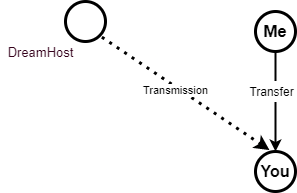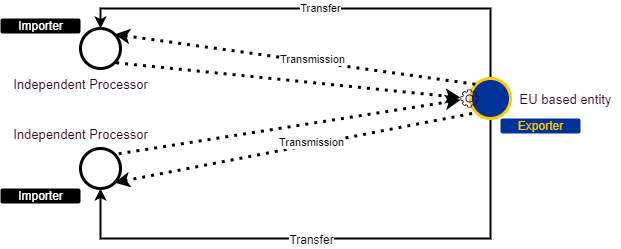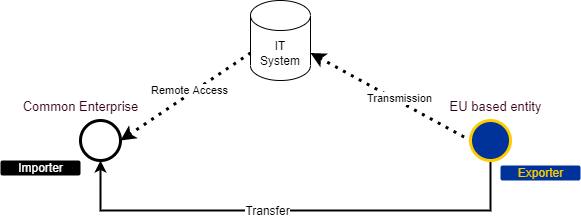International data transfer is probably one of my least favorite privacy exercises. Why? Probably my main dislike deals with the fact that its not really about privacy, but often more about protectionism. That being said, data transfers are a hot hot topic these days, both in Europe and in countries like China and Brazil. It wasn’t until recently that I realized if you look at GDPR from far away, you see there are really four key chapters
- Chapter II – Principles
- Chapter III – Rights of the Data Subject
- Chapter IV – Controllers and Processors
- Chapter V – Transfers
Fundamentally, most people, myself included, equate GDPR to principles of data processing, rights afforded the data subject and obligations of controllers and processers, but right up there with those key concepts is a whole chapter on international data transfers. At least in the minds of the GDPR authors, transfers are clearly not an afterthought but one of the four major components of the regulation.
With data transfers clearly an important element of GDPR, its important that the analysis of transfers be done with some care. I, for one, am a very visual person. I can analogize concepts visually much easier than verbally. Astute readers may have noticed the diagrams accompany my previous post on data transfer regarding the recent draft guidelines put out by the European Data Protection Board. In working through data transfer scenarios, I’ve found it extremely helpful to illustrate or diagram them.
Disambiguating “transfers” and “transmission” of data
Before diving into how to diagram data transfers, it’s important to distinguish the terms transfer and transmit. Transmission of data occurs when data goes from one place to another. If I send you an email with an attachment, I am transmitting data to you. That data is transmitted over multiple servers, through different service providers and maybe through different geographies. A transfer, however, under the GDPR is a legal chain by which a controller or processer transfers data to another controller or processor. In other words the transmission ≠ the transfer.
Perhaps an example would help. I use Dreamhost to host my website. On my website, I host a file (say a pretty infographic). You go to my website and download the file. The file is transmitted from Dreamhost (wherever their servers are) to you (wherever you are) However, there is not a legal transfer from Dreamhost to you. The transfer was from me to you. I may never have even had the file in my possession. Let’s illustrate that.
As you can see, I’ve used dotted lines to illustrate the transmission of data, the 0’s and 1’s flying over the internet from DreamHost to You. But the transfer, the metaphysical or conceptual transfer, from me to you, is illustrated with a solid line. Let’s look at an EU example.
European Union data transfers
Here, ChairFans, GmbH, a German company, sends a file to Star Analytics, Inc., in the US, to analyze. In this case the transmission is parallel to the transfer. ChairFans is transmitting data to Star Analytics and they are also transferring that data. Remember, the transmission refers to the physical bits flying across the Atlantic Ocean and the transfer refers to the act of one entity giving the other entity the data. If you’re still struggling, you can think of it this way. If a hacker broke into ChairFans and stole the data, the data would still be transmitted over the internet across the Atlantic Ocean, but ChairFans didn’t “transfer” data to the hacker. It was not a deliberative, intentional act of making the data available to the hacker.
Do we need a GDPR Chapter V transfer tool for this transfer? If there was
Diagramming
To diagram data transfers, I’m using diagrams.net, a free (and privacy friendly) tool to create diagrams. I’ll provide the file for all these diagrams at the end of this blog. I’ve also included a template for the shapes I’m using, which you can use to create your own data transfer diagrams. For the following example, I’m first going to illustrate the Use Case for supplementary measures in the EDPB Recommendations.
EDPB Recommendation
Use Case 1: Data storage for backup and other purposes that do not require access to data in the clear
A data exporter uses a hosting service provider in a third country to store personal data, e.g., for backup purposes. Notice, I’ve now added the labels, Exporter and Importer to the entities.

Use Case 2: Transfer or pseudonymised Data
A data exporter first pseudonymises data it holds, and then transfers it to a third country for analysis, e.g., for purposes of research. This really isn’t distinguished from the previous example. I’ve added a gear icon to indicate the pseudonymization.
Use Case 3: Encrypted data merely transiting third countries
A data exporter wishes to transfer data to a destination recognised as offering adequate protection in accordance with Article 45 GDPR. The data is routed via a third country.
Use Case 4: Protected recipient
A data exporter transfers personal data to a data importer in a third country specifically protected by that country’s law, e.g., for the purpose to jointly provide medical treatment for a patient, or legal services to a client. No different than illustration 3
Use Case 5: Split or multi-party processing
The data exporter wishes personal data to be processed jointly by two or more independent processors located in different jurisdictions without disclosing the content of the data to them. Prior to transmission, it splits the data in such a way that no part an individual processor receives suffices to reconstruct the personal data in whole or in part. The data exporter receives the result of the processing from each of the processors independently, and merges the pieces received to arrive at the final result which may constitute personal or aggregated data.
Use Case 6: Transfer to cloud service providers or other processor which require access to data in the clear
A data exporter uses a cloud service provider or other processor to have personal data processed according to its instructions in a third country.
Use Case 7: Remote access to data for business purposes
A data exporter makes personal data available to entities in a third country to be used for shared business purposes. A typical constellation may consist of a controller or processor established on the territory of a Member State transferring personal data to a controller or processor in a third country belonging to the same group of undertakings, or group of enterprises engaged in a joint economic activity. The data importer may, for example, use the data it receives to provide personnel services for the data exporter for which it needs human resources data, or to communicate with customers of the data exporter who live in the European Union by phone or email. Here I’ve added an IT system to indicate that the Common Enterprise has remote access to that IT system.
EDPB Guideline on Article 3 and Chapter V
Next up I’ll tackle the examples from the draft EDPB Guidelines on the Interplay Article 3 and Chapter V.
Example 1
Maria, living in Italy, inserts her personal data by filling a form on an online clothing website in order to complete her order and receive the dress she bought online at her residence in Rome. The online clothing website is operated by a company established in Singapore with no presence in the EU. In this case, the data subject (Maria) passes her personal data to the Singaporean company, but this does not constitute a transfer of personal data since the data are not passed by an exporter (controller or processor), since they are passed directly and on her own initiative by the data subject herself. Thus, Chapter V does not apply to this case. Nevertheless, the Singaporean company will need to check whether its processing operations are subject to the GDPR pursuant to Article 3(2).12
Example 2
Company X established in Austria, acting as controller, provides personal data of its employees or customers to a company Z established in Chile, which processes these data as processor on behalf of X. In this case, data are provided from a controller which, as regards the processing in question, is subject to the GDPR, to a processor in a third country. Hence, the provision of data will be considered as a transfer of personal data to a third country and therefore Chapter V of the GDPR applies. Note, I’ve added the labels C and P to indicate Processor and Controller
Example 3: Processor in the EU sends data back to its controller in a third country
XYZ Inc., a controller without an EU establishment, sends personal data of its employees/customers, all of them non-EU residents, to the processor ABC Ltd. for processing in the EU, on behalf of XYZ. ABC re-transmits the data to XYZ. The processing performed by ABC, the processor, is covered by the GDPR for processor specific obligations pursuant to Article 3(1), since ABC is established in the EU. Since XYZ is a controller in a third country, the disclosure of data from ABC to XYZ is regarded as a transfer of personal data and therefore Chapter V applies.
Example 4: Processor in the EU sends data to a sub-processor in a third country
Company A established in Germany, acting as controller, has engaged B, a French company, as a processor on its behalf. B wishes to further delegate a part of the processing activities that it is carrying out on behalf of A to sub-processor C, a company established in India, and hence to send the data for this purpose to C. The processing performed by both A and its processor B is carried out in the context
of their establishments in the EU and is therefore subject to the GDPR pursuant to its Article 3(1), while the processing by C is carried out in a third country. Hence, the passing of data from processor B to sub-processor C is a transfer to a third country, and Chapter V of the GDPR applies.
Example 5: Employee of a controller in the EU travels to a third country on a business trip
George, employee of A, a company based in Poland, travels to India for a meeting. During his stay in India, George turns on his computer and accesses remotely personal data on his company’s databases to finish a memo. This remote access of personal data from a third country, does not qualify as a transfer of personal data, since George is not another controller, but an employee, and thus an integral part of the controller (company A). Therefore, the disclosure is carried out within the same controller (A). The processing, including the remote access and the processing activities carried out by George after the access, are performed by the Polish company, i.e. a controller established in the Union subject to Article 3(1) of the GDPR.
Example 6: A subsidiary (controller) in the EU shares data with its parent company (processor) in a
third country
The Irish Company A, which is a subsidiary of the U.S. parent Company B, discloses personal data of its employees to Company B to be stored in a centralized HR database by the parent company in the U.S. In this case the Irish Company A processes (and discloses) the data in its capacity of employer and hence as a controller, while the parent company is a processor. Company A is subject to the GDPR pursuant to Article 3(1) for this processing and Company B is situated in a third country. The disclosure therefore qualifies as a transfer to a third country within the meaning of Chapter V of the GDPR.
Example 7: Processor in the EU sends data back to its controller in a third country
Company A, a controller without an EU establishment, offers goods and services to the EU market. The French company B, is processing personal data on behalf of company A. B re-transmits the data to A. The processing performed by the processor B is covered by the GDPR for processor specific obligations pursuant to Article 3(1), since it takes place in the context of the activities of its establishment in the EU. The processing performed by A is also covered by the GDPR, since Article 3(2) applies to A. However, since A is in a third country, the disclosure of data from B to A is regarded as a transfer to a third country and therefore Chapter V applies.
My comments to the EDPB
Subsequent to the draft guidelines above, I made a comment to the EDPB on two scenarios they should cover. Those scenarios are detailed below.
A data subject contracts with X, GmbH (in Germany) which is a European Union based subsidiary of X, Inc (in the United States). However, the data subject never actually supplies personal data to X, GmbH as the data subject directly transmit data to X, Inc. in the United States. This is a Chapter V transfer of data requiring a transfer tool. X, GmbH and X, Inc. use standard contractual clauses in place governing the transfer of data. X, GmbH is the exporter and X, Inc. is the importer.
ABC, GmbH (in Germany) instructs employees to use a service provided by X, Inc., in the United States. Employees’ behavior is tracked via the service provided by X, Inc, thus X, Inc. is subject to GDPR for the data under Article 3.2(b). Because ABC, GmbH is “mak[ing] personal data, subject to this processing, available to…” X, Inc. via instructions to its employees, there is a transfer of data under Article V. ABC, GmbH and X, Inc. execute the standard contractual clauses with ABC, GmbH as the exporter and X, Inc. as the importer.
I posed this scenario on LinkedIn
Company X, GmbH (DE) host data on an Australian data server. They contract with Company Y, Inc. in the United States to process data. Company Y’s employee working remotely in Australia, accesses the data on the data server. X, GmbH and Y, Inc. execute Standard Contractual Clauses to govern the transfer. There is a legal transfer of data because X, who has putative control over the data in Australia, gave access to Y, who has putative control over it’s employee in Australia. This despite the fact that the data never left Australia.
If you want to explore these scenarios and make some of you’re own, download this file (be sure to right click and save the file to your desktop). Then go to https://diagrams.net then open the file from there.

















